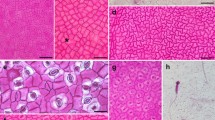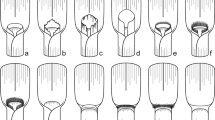Abstract
In two associated families, Celtidaceae and Ulmaceae, vernation pattern (represented by spatial relationships between leaf lamina and stipules, the presence or absence of stipular fusion, lamina orientation, and lamina folding pattern) is consistent within a genus but shows a significant diversity within a family. Six vernation types are distinguishable and tentatively named: 1) Celtis type (Aphananthe, Celtis, Lozanella, Parasponia, Pteroceltis, Trema), 2) Chaetachme type (Chaetachme), 3) Gironniera type (Gironniera), 4) Holoptelea type (Ampelocera, Holoptelea, Phyllostylon), 5) Zelkova type (Hemiptelea, Planera, Zelkova), and 6) Ulmus type (Ulmus). The former three types (found in most of celtidaceous genera) possess free or fused stipules inside of the lamina; in contrast, the latter three types (found in all six ulmaceous genera andAmpelocera) are characterized by having the free stipules outside of the lamina. Within Celtidaceae, Celtis type is probably primitive in having free stipules and an ordinarily oriented lamina; Chaetachme type (with fused, convolute stipules and obliquely oriented laminas) and Gironniera type (with laterally oriented laminas) are the derived. Likewise, within Ulmaceae, both Zelkova and Ulmus types (with laterally oriented laminas) are the derived, while Holoptelea type (with ordinarily oriented laminas) is primitive. Comparisons in vernation pattern suggest the distinctness of Celtidaceae from Ulmaceae and the isolated position ofAmpelocera.
Similar content being viewed by others
References
Chernik, V.V. 1975. Arrangement and reduction of perianth and androecium parts in representative of Ulmaceae. Mirbel and Celtidaceae Link. Bot. Zhurn. Leningrad and Moscow60: 1561–1573. (in Russian).
1980. Peculiarities of structure and development of the pericarp of the representatives of the family Ulmaceae and Celtidaceae. Bot. Zhurn. Leningrad and Moscow65: 521–531. (in Russian).
1981. Pseudomonomeric gynoecium of the Ulmaceae and Celtidaceae. Bot. Zhurn. Leningrad and Moscow66: 958–966. (in Russian).
1982. Characteristics of the structural development of spermoderm in some representatives of Ulmaceae and Celtidaceae. Bot. Zhurn. Leningrad and Moscow67: 1216–1220. (in Russian).
Cronquist, A. 1981. An Integrated System of Classification of Flowering Plants, pp. 189–193. Columbia Univ. Press, New York.
Engler, A. 1893. Ulmaceae.In A. Engler, ed., Die Natürlichen Pflanzenfamilien3, pp. 59–67. Borntraeger, Berlin.
Giannasi, D.E. 1978. Generic relationships in the Ulmaceae based on flavonoid chemistry. Taxon27: 331–344.
Grudzinskaya, I.A. 1967. The Ulmaceae and reasons for distinguishing the Celtidoideae as a separate family Celtidaceae Link. Bot. Zhurn. Leningrad and Moscow52: 1723–1749. (in Russian).
Hagemann, W. 1970. Studien zur Entwicklungsgeschichte der Angiospermenblatter. Bot. Jahrb.90: 297–413.
Henry, A. 1847. Knospengebilder ein Beitrag zur Kenntniss der Laubknospen und der Verzweigungsart der Pflanzen. Acad. Cais Leop. Novae Acta22: 169–342.
Hofmeister, W. 1868. Allgemeine Morphologie der Gewachse. Handb. Physiol. Bot. I. Wilhelm Englemann, Leipzig.
Hutchinson, J. 1967. The Genera of Flowering Plants. 2, pp. 144–150. Clarendon Press, Oxford.
Link, D.H.F. 1831. Handbuch zur Erkennung der Nutzbarsten und am Haufigsten Vorkommenden Gewachse. Haud & Spenerschen (S.J. Joseephy), Berlin.
Oginuma, K., P.H. Raven and H. Tobe. Karyomorphology and relationships of Celtidaceae and Ulmaceae (Urticales). Bot. Mag. Tokyo103: 113–131.
Planchon, J.E. 1873. Ulmaceae.In A.P. de Candolle, ed., Prodromus Systematis Naturalis Regni Vegetabilis. Vol. 17, pp. 151–210. Truettel & Wurtz, Paris.
Sharp, A.J. 1958.Mirandaceltis, a new genus from Mexico (1). Bol. Soc. Bot. Mexico23: 38–42.
Soma, S. 1965. Developmental studies on the orientation and the dorsiventrality of the leaf ofZelkova serrata Makino. J. Fac. Sci. Tokyo III,9: 1–17.
1972. Further observations on leaf orientation inZelkova serrata. Bull. Rissho Wemen's Univ.6: 99–103.
1982. On the orientation and the dorsiventrality of the leaf ofBegonia fagifolia. Ann. Rep. Fac. Educ. Bunkyo Univ.16: 65–73. (in Japanese).
1984. On the orientation and the dorsiventrality of the leaf ofBegnia fagifolia II. Ann. Rep. Fac. Educ. Bunkyo Univ.18: 45–54. (in Japanese).
Sweitzer, E.M. 1971. Comparative anatomy of Ulmaceae. J. Arnold Arbor.52: 523–585.
Takahashi, M. 1989. Pollen morpholgy of Celtidaceae and Ulmaceae: a reinvestigation.In P.R. Crane and S. Blackmore, ed., Evolution, Systematics and Fossil History of the Hamamelidae. Vol. 2: Higher Hamamelidae. Systematic Association Special volume40B: 253–265. Clarendon Press, Oxford.
Takaso, T. andH. Tobe. 1990. Seed coat morphology and evolution in Celtidaceae and Ulmaceae (Urticales). Bot. Mag. Tokyo103: 25–41.
Takhtajan, A. 1980. Outline of the classification of flowering plants (Magnoliophyta). Bot. Rev.46: 225–359.
Zavada, M. 1983. Pollen morphology of Ulmaceae. Grana22: 23–30.
Author information
Authors and Affiliations
Rights and permissions
About this article
Cite this article
Terabayashi, S. Vernation patterns in Celtidaceae and Ulmaceae (Urticales), and their evolutionary and systematic implications. Bot Mag Tokyo 104, 1–13 (1991). https://doi.org/10.1007/BF02493399
Received:
Accepted:
Issue Date:
DOI: https://doi.org/10.1007/BF02493399




